It’s World Frog Day!
March 20th is the date we observe World Frog Day. When one conjures up images of frogs, it is often rainforest frogs, such as the Red-eyed Leaf Frog which may come to mind first. Like the Keel-billed Toucan, this frog has been seen so often in advertising, merchandise, and cartoons that you’d hardly believe it was real. But indeed, it is a common and widespread species in Central American rainforests. Like other members of the Hylidae, or tree frog family, it has unique fingers and toes whose ends are expanded into adhesive disks that act as suction cups.
Frogs I’ve been lucky to meet
The Red-eyed Leaf Frog, Agalychnis callidryas, is just one of over 147 species of frogs and toads that have been identified in Costa Rica alone, and there are likely many more. They range in appearance from minuscule Dink Frogs no larger than your pinkie fingernail to 3-pound Cane Toads. Some species are familiar to most, like the brightly patterned Red-eyed Leaf Frog. Others are known only to those who brave the heat and humidity of a lowland rainforest and look carefully on the undersides of leaves, amongst the leaf litter, and in the axils of epiphytic bromeliads.
Once, I was lucky to see mating pairs of these frogs in Honduras as they were precariously balanced on a stem of a banana plant that was hanging over a small pond.

Red-eyed Leaf Frogs
Rainforests are a great place to see frogs, and amphibians in general, thanks not only to their rich species diversity but also since the perennially moist and humid climate allows them the freedom to occupy more habitats without fear of desiccation. Unlike northern hemisphere species that are tied to aquatic habitats because their skin must be moist to absorb oxygen, frogs living closer to the equator are freed to live anywhere, even in trees.
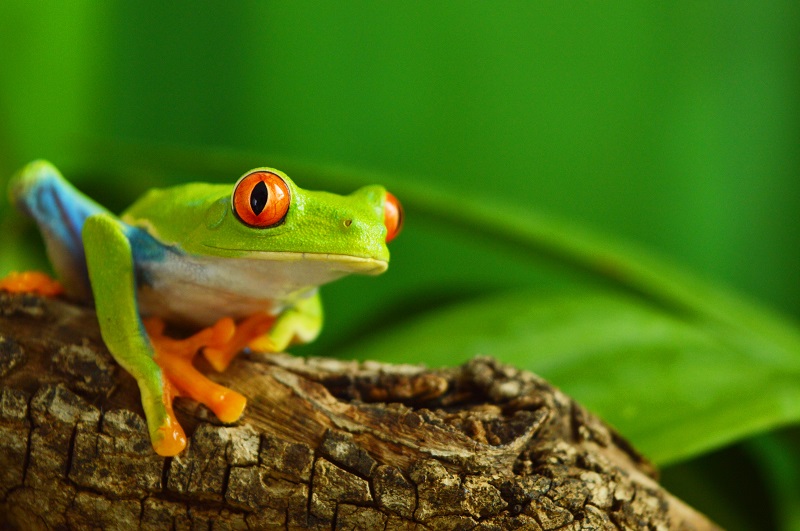
Smoky Jungle Frog
The Smoky Jungle Frog, Leptodactylus savagei, is the largest frog in Costa Rica, as you might guess from the photo below, and is second only in size to the Marine Toad, reaching 6 inches long. They are widespread in Central America and northern South America, being found in a range of habitats and elevations.
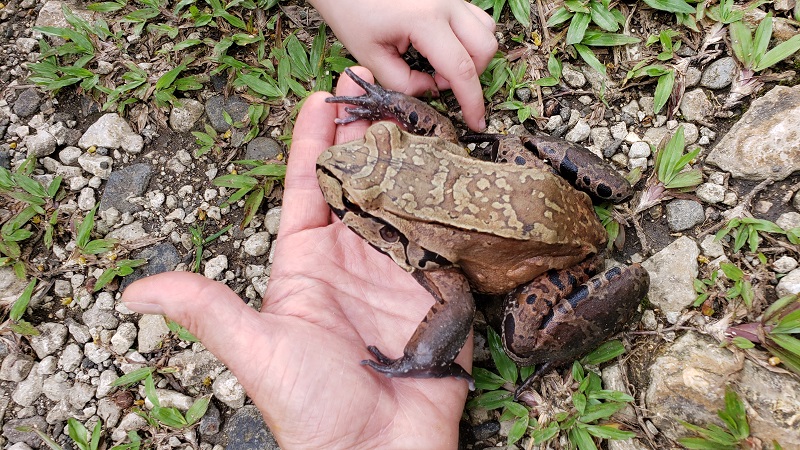
Smoky Jungle Frog
We found this specimen sitting on the front lawn of the birdwatching lodge I was staying at, Rancho Naturalista. I picked it up to move it to a safer spot, not knowing that they apparently can secrete a very irritating toxin to ward off predators. Apparently, it didn’t consider me a threat but did indeed immediately jump out of my grasp and hopped at lightning speed across the lawn and into the forest, from where we often hear him calling at night. The species is also known for emitting a loud ‘scream’ when threatened, which unfortunately I was not lucky enough to experience.
According to my research, it apparently eats just about anything; including other frogs, birds, chicks, snakes, crabs, crayfish, invertebrates, and is supposedly the only frog known to eat scorpions!
I loved the beautiful coloration of this species, especially its copper-colored eyes and bronze-tinged sides.
Crowned Tree Frog
This Crowned Tree Frog, Anotheca spinosa, is valiantly guarding her tadpoles which she was raising inside the protected nursery site of a bamboo stem. This frog is quite unique, being the only species in its genus, and sporting a bony crown of knobs and spines on top of its head. Like poison dart frogs, the female nourishes the voracious tadpoles with a diet of unfertilized eggs laid directly in the water. Yum!
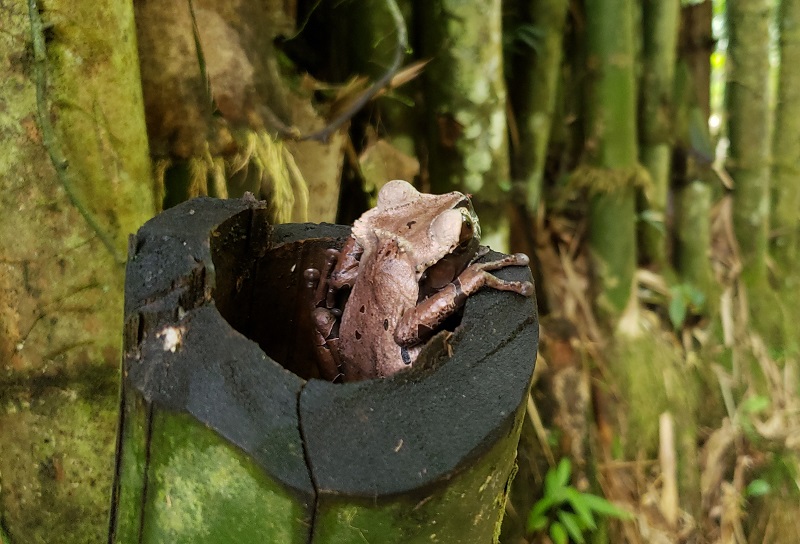
Below is a short video clip of a crowned tree frog I found that was incubating her eggs in a cut off bamboo stalk. Although I have walked by this stalk many times, I’ve only been lucky enough once to see the female perched on its edge, and thankfully I had my camera with me!
Reticulated Glass Frog
We were lucky to spot a Reticulated Glass Frog, Hyalinobatrachium valerioi, during a hike through a patch of lowland rainforest on the Atlantic side of Costa Rica. The frog was on the underside of a leaf that was overhanging a small creek. The species always places their eggs masses here so that when the tadpoles emerge from the egg, they simply drop into the creek. How ingenious!
In this species, it is the male who does the duty of watching over the eggs, day and night, to protect them from parasitic flies and other insects, and keep them hydrated by moistening them with water released from his bladder. Notice the egg-like pattern of spots on his back that may serve to fool insects into thinking he’s just another egg mass, thus luring the predators close enough to eat them!
Its small, transparent body perfectly matched the color of the leaf and we could see through the frog’s delicate skin to its skeleton and internal organs.

Reticulated Glass Frog
The Brilliant Forest Frog
The Brilliant Forest Frog, Rana warszewitschii, not to be confused with the Splendid Leaf Frog (though they’re all brilliant and splendid in my book!) is commonly seen since it’s diurnal and ground-dwelling. Folks see it, as I did, among trail-side leaf litter, though it’s mottled coloration aptly camouflages it if it doesn’t jump out of your way, as it did on a recent hike at Arenal Volcano National Park.
Like other ‘true frogs’ in the Ranidae family, it has a pair of ridges along its back and also long, muscular legs for long-distance jumping. When it does jump, it readily displays bright red and yellow bands of color that may serve to startle would-be predators as it jumps out of harm’s way. You can see a couple of the yellow spots in the photo below.
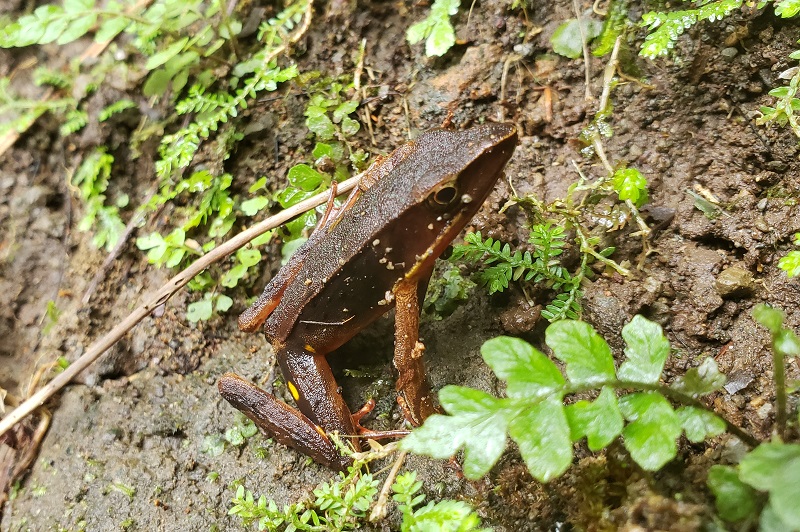
Brilliant Forest Frog
Poison Dart Frogs
All poison dart frogs belong to the family Dendrobatidae, and all 187+ species reside in the humid lowland rainforests of Central and South America, from Nicaragua to Brazil.
Each species is easy to recognize by its unique and beautiful color pattern which signals to potential predators the toxicity of the alkaloid poisons sequestered in granular skin glands. Frogs develop the poisons from their diet of spiders, ants, termites, centipedes, and beetles, but it is unclear whether the poison originates from their prey, or from the diet of the prey items themselves. Interestingly, captive frogs do not have the poison, and some species can easily be raised in captivity and are popular as pets.
Dart frogs have always been on my ‘target list’ of tropical species to see, and were one of the reasons I wanted to visit Costa Rica. I had imagined that they would be larger, but once I finally saw one, I was surprised that it was only about as big as my thumb. Once I had honed my ‘search image’ for something that small, I began to spot more.
This is the Strawberry Poison Dart Frog, Oophaga pumilio, also known as the Blue Jeans Frog for obvious reasons. This species of poison dart frog is common, widespread, and often seen due to its diurnal nature. We saw several at a time along the trails of Selvaverde Lodge and other locations within its range on the eastern side of Costa Rica.
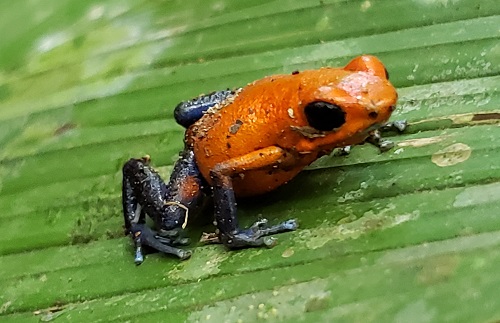
Once seen, they are easy to observe because they don’t hop away like a ‘normal’ frog. Their short, stubby legs only allow them to amble slowly and awkwardly across the forest floor. They are also easier to see than some other frog species in that they are more terrestrial. The males like the one in this photo will generally ascend only as far as a log or small plant, from which they vocalize their territorial and courtship calls.
Males of the Strawberry Dart Frog engage in epic wrestling matches to win territories and gain the favor of females. Once a female has chosen her preferred mate, he leads her to a moist site on the forest floor where he will fertilize a small clutch of about 10 eggs. The reason for such a small clutch soon becomes apparent.
Once the eggs hatch into tadpoles they are carried by the female to a nearby bromeliad plant and there she carefully places each tadpole in a separate leaf axil. Thus, each tadpole resides in its own personal swimming pool nursery and there it resides for 40 days or so as it matures. Each day, the female will return to the bromeliad and nourish each tadpole with an unfertilized egg she deposits for it to dine on. So you can imagine how much time and effort the female dedicates and that’s why she only raises a small number of young at once.
LEARN MORE ABOUT DART FROGS HERE
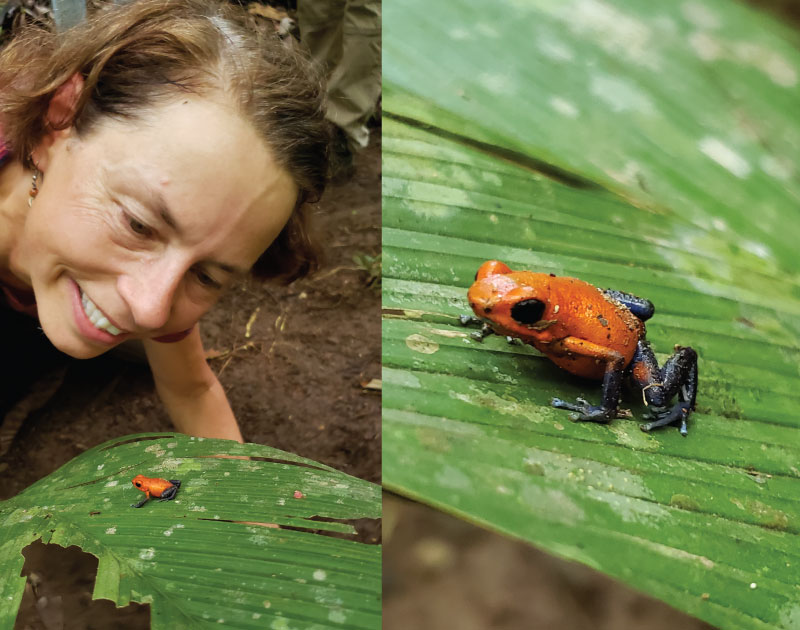
Christine with a Strawberry Poison Dart Frog
Cane Toad
Like most species in the toad family, Bufonidae, the Cane Toad, Bufo marinus, is a short-limbed, stocky frog with warty skin. It is one of the world’s largest toads, weighing up to 3 pounds! It is recognized by both its prominent cranial crests and the enormous parotid glands located behind its eardrum that secrete copious amounts of a milky-white toxin when threatened by would-be predators.
It is common and widespread throughout its native range in Central America but has expanded farther north and south as well as becoming an ecological disaster in Australia where it was introduced in 1935 in the hopes that it would control a crop pest. No such luck.
As a voracious predator with a high reproduction rate, deadly toxicity, and the ability to live in human degraded habitats, the Cane Toad, has become a much-hated and feared species. If you come across one of these guys, commonly encountered at night among building with lights that attract insect prey, do avoid handling them. I spotted this big guy below at the Monteverde Cloud Forest Preserve.

Cane Toad
CLICK TO LEARN MORE ABOUT DART FROGS
Tutorial on Drawing Dart Frogs
Tutorial on Drawing a Tree Frog

